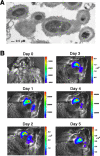Genetic requirement for pneumococcal ear infection
- PMID: 18670623
- PMCID: PMC2593789
- DOI: 10.1371/journal.pone.0002950
Genetic requirement for pneumococcal ear infection
Abstract
Background: Ear infection or otitis media (OM) accounts for most bacterial respiratory infections in children in both developed and developing nations. Streptococcus pneumoniae, nontypeable Haemophilus influenzae, and Moraxella catarrhalis are the major OM pathogens. However, little is known about the genetic basis of bacterial OM largely due to practical difficulties in conducting research in ear infection models and genetically manipulating clinical isolates. Here, we report the first genome-scale in vivo screen for bacterial genes required for ear infection in a chinchilla model by signature tagged mutagenesis (STM), a high throughput mutant screen technique.
Methodology/principal findings: STM strains were constructed with a multi-drug resistant OM isolate ST556 (serotype 19F) and screened in a chinchilla OM model. Out of 5,280 mutants tested, 248 mutants were substantially underrepresented in the mutant pools recovered from the middle ear fluids of the infected chinchillas, indicating the impaired ability to survive and replicate in the middle ears due to genetic disruptions in the chromosome of strain ST556. Further DNA sequencing analysis mapped the mutations to 169 pneumococcal genes. Surprisingly, only 52 of these genes were required for pneumococcal nasopharyngeal colonization in a murine model. This infection site-specific gene requirement was verified by targeted mutagenesis in the selected genes.
Conclusions/significance: These findings suggest that there are a subset of pneumococcal genes required for ear infection and that these may be distinct from those required for nasal colonization. Our data thus provide comprehensive gene targets for mechanistic understanding of pneumococcal ear infection. Finally, this study has also developed a model for future genome-scale search for virulence determinants in other pathogens associated with ear infections.
Conflict of interest statement
Figures




References
-
- Giebink GS. The prevention of pneumococcal disease in children. N Engl J Med. 2001;345:1177–1183. - PubMed
-
- Freid VM, Makuc DM, Rooks RN. Ambulatory health care visits by children: principal diagnosis and place of visit. Vital Health Stat. 1998;13:1–23. - PubMed
-
- Lim DJ, Hermansson A, Hellstrom SO, Hussl B, Alper CM, et al. Recent advances in otitis media. 3. Animal models; anatomy and pathology; pathogenesis; cell biology and genetics. Ann Otol Rhinol Laryngol Suppl. 2005;194:31–41. - PubMed
-
- Barenkamp SJ, Kurono Y, Ogra PL, Leiberman A, Bakaletz LO, et al. Recent advances in otitis media. 5. Microbiology and immunology. Ann Otol Rhinol Laryngol Suppl. 2005;194:60–85. - PubMed
-
- Kadioglu A, Weiser JN, Paton JC, Andrew PW. The role of Streptococcus pneumoniae virulence factors in host respiratory colonization and disease. Nat Rev Microbiol. 2008;6:288–301. - PubMed
Publication types
MeSH terms
Substances
Grants and funding
LinkOut - more resources
Full Text Sources
Other Literature Sources
Medical
Molecular Biology Databases

